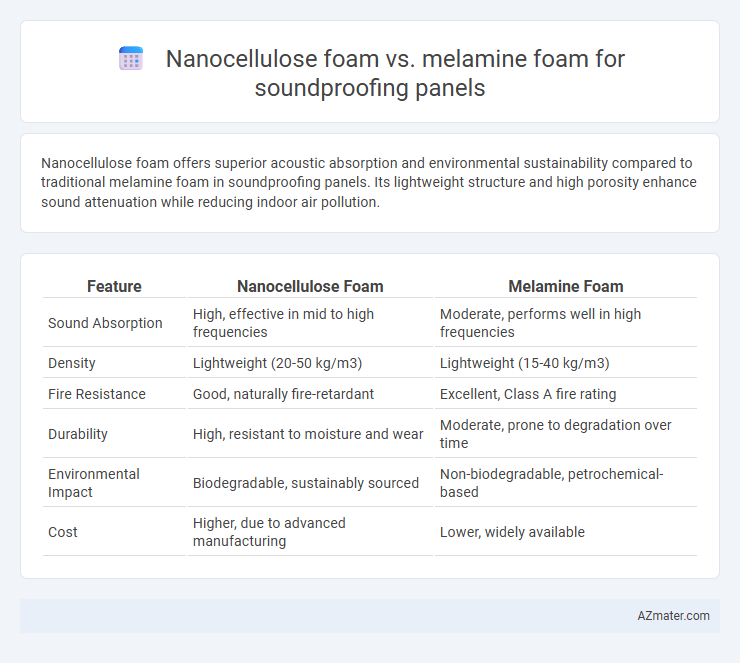Nanocellulose foam offers superior acoustic absorption and environmental sustainability compared to traditional melamine foam in soundproofing panels. Its lightweight structure and high porosity enhance sound attenuation while reducing indoor air pollution.
Table of Comparison
| Feature | Nanocellulose Foam | Melamine Foam |
|---|---|---|
| Sound Absorption | High, effective in mid to high frequencies | Moderate, performs well in high frequencies |
| Density | Lightweight (20-50 kg/m3) | Lightweight (15-40 kg/m3) |
| Fire Resistance | Good, naturally fire-retardant | Excellent, Class A fire rating |
| Durability | High, resistant to moisture and wear | Moderate, prone to degradation over time |
| Environmental Impact | Biodegradable, sustainably sourced | Non-biodegradable, petrochemical-based |
| Cost | Higher, due to advanced manufacturing | Lower, widely available |
Introduction to Soundproofing Panels
Soundproofing panels are engineered materials designed to absorb and block sound waves, enhancing acoustic environments in residential, commercial, and industrial spaces. Nanocellulose foam offers superior biodegradability, high porosity, and excellent sound absorption coefficients, making it an innovative eco-friendly alternative to traditional materials. Melamine foam, known for its open-cell structure and resilience, provides effective noise reduction with fire resistance and moisture tolerance widely used in professional soundproofing applications.
Overview of Nanocellulose Foam
Nanocellulose foam is an innovative, eco-friendly material derived from plant fibers, offering exceptional acoustic absorption due to its porous nanostructure. Compared to traditional melamine foam, nanocellulose foam provides superior soundproofing performance with enhanced durability and biodegradability. Its lightweight nature and high surface area make it ideal for use in soundproofing panels requiring sustainable solutions without compromising acoustic efficiency.
Overview of Melamine Foam
Melamine foam is an open-celled, lightweight material with excellent sound absorption properties, often used in acoustic panels and soundproofing applications. Its porous structure effectively dampens mid to high-frequency noise by trapping sound waves and converting them to heat, making it suitable for reducing echo and reverberation in various environments. Compared to nanocellulose foam, melamine foam offers superior fire resistance and thermal stability, which enhances its performance and safety in soundproofing installations.
Acoustic Performance Comparison
Nanocellulose foam demonstrates superior acoustic absorption due to its highly porous, lightweight structure and nanoscale fiber network that efficiently dissipates sound waves across a broad frequency range. Melamine foam provides good soundproofing with an open-cell structure but tends to be less effective at low frequencies and has lower durability under heavy acoustic loads. Comparative studies show nanocellulose foam achieves higher Noise Reduction Coefficient (NRC) values, making it a more efficient material for soundproofing panels in both commercial and residential applications.
Material Sustainability and Environmental Impact
Nanocellulose foam, derived from renewable biomass such as wood pulp, offers superior biodegradability and a lower carbon footprint compared to melamine foam, which is a petroleum-based synthetic polymer with limited recyclability. The production of nanocellulose foam involves less energy-intensive processes and emits fewer greenhouse gases, promoting a more sustainable lifecycle for soundproofing panels. While melamine foam provides effective acoustic insulation, its environmental persistence and potential toxicity during manufacturing and disposal present significant ecological challenges.
Durability and Lifespan
Nanocellulose foam exhibits superior durability and a longer lifespan compared to melamine foam due to its robust cellulose fiber structure, which resists compression and degradation over time. Melamine foam, while effective for sound absorption, tends to deteriorate faster under continuous mechanical stress and environmental exposure. The extended longevity of nanocellulose foam makes it a more cost-efficient and sustainable choice for long-term soundproofing applications.
Installation and Handling Differences
Nanocellulose foam offers lightweight and flexible properties, making it easier to cut and shape during installation compared to the rigid and brittle structure of melamine foam, which requires careful handling to avoid breakage. Nanocellulose panels typically exhibit higher moisture resistance, reducing the need for protective barriers during installation, whereas melamine foam may degrade if exposed to humidity. The eco-friendly nature of nanocellulose foam also allows for simpler disposal and handling protocols, while melamine foam demands stricter safety measures due to its synthetic chemical composition.
Cost Comparison and Economic Feasibility
Nanocellulose foam offers superior sound absorption but comes with higher material and production costs compared to melamine foam, which is more economically viable for large-scale soundproofing projects. Melamine foam provides a cost-effective solution with established manufacturing processes and lower raw material expenses, making it suitable for budget-conscious applications. The economic feasibility of nanocellulose foam improves with advancements in production technology and increased demand, potentially reducing costs over time.
Safety and Health Considerations
Nanocellulose foam offers superior safety and health benefits compared to melamine foam, as it is derived from renewable plant fibers, making it biodegradable and non-toxic. Melamine foam, while effective for soundproofing, can release irritant particles and formaldehyde under high temperatures, posing respiratory risks. Nanocellulose's hypoallergenic properties and absence of volatile organic compounds (VOCs) make it a safer choice for indoor environments requiring sound absorption.
Conclusion: Choosing the Right Foam for Soundproofing
Nanocellulose foam offers superior biodegradability and eco-friendly sound absorption with high porosity, making it ideal for sustainable soundproofing applications. Melamine foam provides excellent fire resistance and lightweight acoustic insulation, suited for commercial and industrial soundproofing needs. Selecting the right foam depends on balancing environmental impact, fire safety requirements, and acoustic performance criteria.

Infographic: Nanocellulose foam vs Melamine foam for Soundproofing panel
 azmater.com
azmater.com